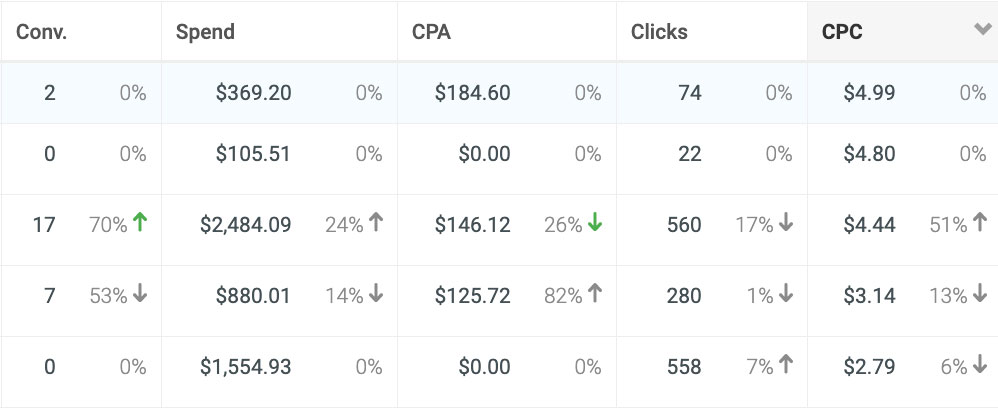When it comes to pay-per-click campaigns – or any digital marketing effort, for that matter – CEOs are naturally going to want to dive into the details. But how can they keep on top of cost and performance without getting bogged down in the weeds?
In this post, we’ll look at five do’s and five don’ts to help CEOs get the most out of their digital marketing teams. We call it macro-management.
The beauty and curse of digital marketing is that there is so much data at our fingertips. There are tons of questions to dissect, and countless ways to visualize everything. This is a tiny segment of the metrics available:

Busy CEOs simply don’t have time for it all.
Still, executives need to be able to monitor their team’s execution and how their PPC and display campaigns are performing. How can they get it done?
Let’s start with what not to do.
Five Digital Marketing Things CEOs Shouldn’t Do
Don’t Ask to See “The Keyword List” for PPC Campaigns
Let’s assume your team is up to speed on what you do as a company and your competition. (If they are not, that is an entirely different problem.) Let’s also assume they’re well-trained, certified pros that have access to research tools like Moz, Google Keyword Planner and SpyFu.
The reason you shouldn’t ask to see terms is because these tools provide guidance and suggestions based on actual search and ad spend data. It’s more than gut intuition. Also, when managed properly, the list of terms you are bidding on will evolve. Terms will be added and removed based on competition, cost, opportunities and performance.
In other words, there is no keyword list. If you’re getting good conversions consistently, roll with it. If you’re not, it could be 1,000 things; the keywords are only one part.
Don’t Obsess Over Individual Ads
You absolutely want to make sure company brand standards are being adhered to. But as CEO, you shouldn’t focus on the individual ads. Leave that to the people you hired to do that job. Why? Because your opinion really doesn’t matter.
(Sorry.)
Case in point: We had a CEO who hated one of the ad concepts we presented. Research showed in her particular industry, digital display ads that had a person’s face as a focal point of the ad outperformed the same ad copy without the person’s face. She didn’t care. She didn’t like the person’s face. We pushed and asked her to let us test the ad against the two she liked. Guess which one won, hands down?
In other words, it doesn’t matter what you like – it matters what converts.
Don’t Ask to Test New Creative Too Early
It’s tempting to clamor for new ads if you’re not seeing results right away. It has to be the creative, right? Not exactly. It takes time to generate meaningful results. There are so many factors that go into a winning PPC effort. Creative is just one key ingredient.
The best approach is to put two different ads for the same campaign out there at the same time and see which creative – image, headline, etc. – performs best. Give your team time to get statistically relevant results. Here, you want to look at total clicks. If after a couple thousand impressions the second ad generates significantly more clicks than the first ad, then drop the first one from rotation and test different creative/messaging. But give it time to generate enough data.
Don’t Click On Your Own Ads
This one’s easy. It’s really tempting as CEO when you see one of your ads “in the wild” to give it a click. That usually costs you money. Don’t click your own ads.
Don’t Freak Out If Someone Sees Your Ad on an Unrelated Site
I had a CEO say to me once “Why on earth would I want an ad for my company on that site? They are NOT my prospects.” Slow down there, chief. First, PPC – how the Google Display Network usually works – means you only pay if someone clicks. Impressions – the number of people seeing the ad – are free.
As long as they don’t click, no harm, no foul. If the ad was a remarketing ad that means the person was on your website at one point – an indicator that perhaps they actually are qualified. If so, the ad following them around the internet – even to sites not directly related to your business – will keep your business top of mind.
Now that we’ve looked at a few things you should NOT do, we’re ready to tackle what you should be doing. Let’s dig in.
Five Digital Marketing Things CEOs Should Do
Request Thorough Reports Monthly
You will drive yourself (and your marketing team) crazy if you are asking to see a daily report. Again, if you trust your team, get briefed once per month on what’s working and what’s not. Ask to see trendlines, not daily movement. Use it as an opportunity to gain insight and discuss ways to refine overall effort.
Know What a Conversion Is Worth
In today’s digital world, we can measure just about anything – at a cost. But when it comes to digital marketing and PPC, the most important financial number CEOs must know is the value of a conversion. By conversion, I mean someone clicking through and taking the desired action – like requesting a demo or a meeting.
Let’s do a little math.
First, calculate the lifetime value (LTV) for an average new client: LTV = The amount the average client pays your business per year X the length of time the average client sticks around.
Why is this important? I had a CEO say to me once he refused to do PPC as part of his marketing program because it was costing him $50/click and they were only converting 1 out of 20 clicks to a demo. So the cost for conversion was $1,000.
About 1 in 25 conversions led to a deal. So it cost him $25,000 to get a deal. “That’s crazy,” he said. Not really. His company’s solution commanded a seven-figure price tag and five figures in annual maintenance – and the typical client stuck around for seven years. The LTV was about $3 million. Sure seems worth investing $25,000 to get $3 million.
Now, if you know your LTV, your marketing team should be able to build a PPC model that caps the spend per click at an acceptable rate based on this entire equation.
Trust Your People
You hired them. You will know quickly if you’re dealing with someone who knows what they’re talking about – or if they are blowing smoke and hiding behind data. If you can’t trust the whole team, that is a very different issue. But if you hired someone to do a job – one that is very detailed with a ton of moving parts – you need to be able to trust that they can do it.
Understand the Digital Marketing Math
Don’t get all up in your marketing team’s grill if the click-through rate (CTR) on retargeting ads is “only” 1.5% or if a landing page is “only” converting at 3%. Keep in mind, while we have the ability to target specific demographic, geographic and other kinds of profiles, digital advertising is a scale game.
An expected CTR on retargeting is less than 1%. An acceptable conversion rate on a landing page is often around 2%. Know the industry and general standards – and understand that there are different standards for different ad types.
Ask your team to set benchmarks and share trendlines in the monthly report. Also, know that it’s not uncommon for a new campaign to act like a locomotive. It may be slow to build steam and really get moving. Odds are that the first 50 clicks will give you little economic benefit – but a wealth of insight. Remember, unless you are a pure buy now or volume play, you’re looking for that one or two in a hundred that are something – and building on that.
Look at the Big Picture
It’s not just about the PPC, or the remarketing, or the display ads. It’s the whole journey.
You’re trusting your digital marketing person (or digital marketing agency) to bring in leads. It’s on you to look at everything else.
Case in point: A client had a campaign running for a while that was well within the bounds of an acceptable CTR and conversion rate. But they were only closing 1 out of 30 prospects that reached the demo phase. The visceral response of the CEO? “We need more leads!” The reality is they needed to look at how to better close the leads they were getting.
Conclusion
Digital marketing and PPC are complex. As CEO, you don’t have time to workshop the wording on the CTA button. Your job is to focus on the bigger picture. This means ROAS – return on ad spend. Make sure this is included in your monthly and quarterly reports. Facilitate building a closed feedback loop where sales can report back to marketing on the quality of the leads, including whether or not a prospect closed and why.
If you follow the basic principles outlined in this post – along with some fine tuning specific to your business and team – you will be managing PPC campaigns on a macro level in no time.
Need help micro-managing your digital marketing campaigns? Our team of B2B lead generation experts can help. Contact us today to learn more.



